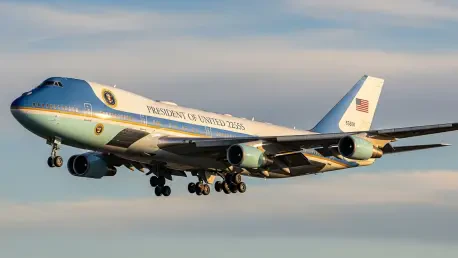I’m thrilled to sit down with Donald Gainsborough, a political savant and leader in policy and legislation, who heads Government Curated. With his deep expertise in defense policy and military procurement, Donald offers unparalleled insight into the Pentagon’s recent request to redirect $5.4 billion in previously approved funds. In this interview, we explore the motivations behind this financial shift, the urgency surrounding the Air Force One replacement program, the strategic importance of missile defense systems, and the broader implications of reallocating resources across critical defense initiatives. Join us as we unpack these complex topics with clarity and depth.
Can you walk us through the reasons behind the Defense Department’s request to redirect $5.4 billion in previously approved funds?
Certainly, Ethan. The Pentagon’s request to shift $5.4 billion reflects a need to adapt to evolving military priorities and unforeseen challenges. This isn’t just about moving money around; it’s about addressing urgent national security needs that have emerged since the original budgets were set. The funds are being reallocated to programs deemed critical, like accelerating the Air Force One replacement, bolstering missile defense capabilities, and investing in cutting-edge technologies such as hypersonic missiles. The core idea here is flexibility—when new threats or delays in existing programs arise, the Department has to pivot to ensure readiness and protect national interests.
What specific priorities or programs are receiving this redirected funding, and how were those decisions made?
The bulk of the funding is going to high-priority areas like the VC-25B aircraft for Air Force One, with $150 million to speed up delivery, and over $500 million for the THAAD missile-defense system, which has been depleted after recent operations. There are also investments in innovative projects like the Army’s autonomous launcher and hypersonic missile development. The decision-making process involves a rigorous assessment of military requirements, often driven by combatant commanders’ input and intelligence on emerging threats. It’s a balancing act—Pentagon leaders weigh current operational needs against long-term strategic goals, ensuring that the most pressing gaps are filled first.
Focusing on Air Force One, why is there such a push to accelerate the delivery of the VC-25B aircraft from 2029 to 2027?
The push to move up the timeline by two years stems from both operational necessity and political will. The current Air Force One fleet is aging, and maintaining it is becoming increasingly costly and risky in terms of reliability. Delays in the VC-25B program have already pushed the timeline out further than anticipated, so there’s a real concern about having a capable presidential transport ready when it’s needed. Accelerating to 2027 with an additional $150 million is seen as a way to mitigate those risks, ensuring the aircraft can be fielded sooner through investments in long-lead spares and support infrastructure.
What kinds of challenges have caused delays in the Air Force One replacement program, and how might this extra funding help?
The VC-25B program has faced a host of issues, from supply chain bottlenecks to technical complexities in customizing a Boeing 747 for presidential use. Integrating advanced communication systems, security features, and defensive countermeasures isn’t straightforward, and these requirements often lead to cost overruns and timeline slips. The $150 million injection is aimed at addressing some of these hurdles by securing critical components early—like spare parts that take years to produce—and enhancing operational support to streamline the final assembly and testing phases.
There’s talk of relaxing certain requirements to speed up the Air Force One delivery. Can you shed light on what that might involve?
Relaxing requirements could mean reevaluating non-critical specifications that don’t directly impact safety or core functionality. For instance, some interior design elements or secondary systems might be simplified or deferred to a later upgrade. It’s about prioritizing what’s essential for the aircraft to operate securely as a presidential transport. The goal is to cut through red tape or overly ambitious standards that are holding up progress without compromising the mission.
When it comes to the interim solution of retrofitting a Boeing 747 once owned by the Qatari royal family, what’s the story behind choosing this particular aircraft?
This was a pragmatic decision driven by availability and timing. The Qatari jet was a readily accessible Boeing 747, a platform already familiar to the Air Force for presidential transport. Acquiring an existing aircraft like this bypasses the long lead times of building from scratch, even if it requires extensive retrofitting to meet security and operational standards. It’s essentially a stopgap to ensure there’s no gap in capability while the VC-25B program catches up.
With the retrofit costing nearly $1 billion, what factors are driving such a high price tag for this temporary solution?
The cost is staggering because retrofitting isn’t just a paint job—it’s a complete overhaul. You’re talking about installing military-grade communication systems, reinforcing the aircraft for defensive measures, and customizing it to handle the unique demands of presidential travel. Every system has to be hardened against potential threats, and that level of engineering, testing, and certification doesn’t come cheap. Plus, the urgency of the project likely means paying a premium for expedited work and specialized contractors.
The funding for this retrofit is coming from ‘early to need’ money from the Sentinel missile program. Can you explain what ‘early to need’ means and whether this reallocation poses any risks?
‘Early to need’ refers to funds that were allocated for a program but aren’t required immediately because of delays or shifts in scheduling. In the case of the Sentinel missile program, some phases might not be ready to ramp up, so the money is sitting unused for now. Redirecting it to the Qatari jet retrofit makes sense on paper, but it’s not without risks. If the Sentinel program suddenly needs to accelerate due to unforeseen developments, there could be a shortfall. It’s a gamble, banking on the missile program’s delays holding steady.
Shifting gears to the THAAD missile-defense system, why is it receiving over $500 million in this reprogramming request, and what makes it so urgent?
THAAD, or Terminal High Altitude Area Defense, is critical for intercepting ballistic missiles, and recent conflicts have drained a significant portion of the inventory—about a quarter was used in a short 12-day period during operations involving Israel and Iran. The $500 million is meant to replenish stocks, address obsolescence issues through redesigns, and ensure commanders have enough interceptors for future threats, including initiatives like the Golden Dome for America. The urgency comes from the unpredictable nature of missile threats—without adequate defenses, we’re vulnerable to catastrophic attacks.
Looking at the bigger picture, how do you see these funding shifts impacting the Pentagon’s long-term strategic goals?
These reallocations highlight the constant tension between immediate needs and long-term planning. On one hand, addressing urgent gaps—like missile defense or presidential transport—strengthens our posture today. On the other, pulling funds from programs like Sentinel or cutting outdated systems risks delaying modernization efforts that are crucial for tomorrow’s challenges. The Pentagon is trying to strike a balance, but repeated reprogramming can erode trust with Congress and create uncertainty for defense contractors. Over time, it might lead to a more reactive than proactive strategy, which isn’t ideal for sustained readiness.
As we wrap up, what’s your forecast for how defense funding priorities might evolve in the coming years given these kinds of urgent reprogramming requests?
I expect we’ll see more of these urgent requests as geopolitical tensions rise and technology advances at a breakneck pace. Missile defense and cyber capabilities will likely remain top priorities, given the growing sophistication of threats. At the same time, aging infrastructure—like the Air Force One fleet—will force tough choices about where to invest. My forecast is that Congress and the Pentagon will need to develop more flexible budgeting mechanisms to handle these rapid shifts, possibly through contingency funds or streamlined approval processes. Without that, we risk falling into a cycle of constant catch-up, which could undermine our strategic edge.









